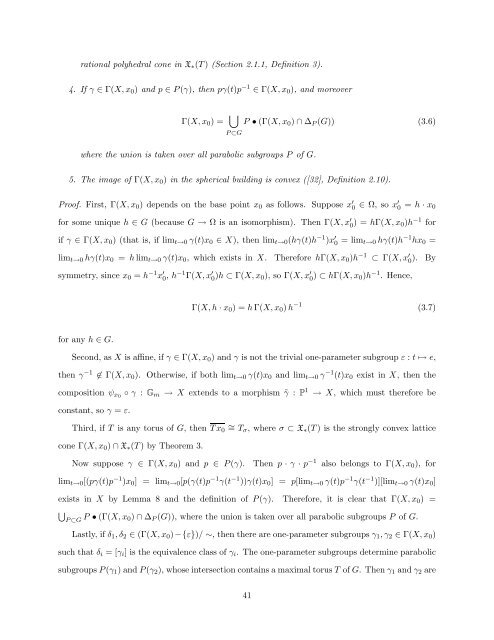Equivariant Embeddings of Algebraic Groups
Equivariant Embeddings of Algebraic Groups
Equivariant Embeddings of Algebraic Groups
You also want an ePaper? Increase the reach of your titles
YUMPU automatically turns print PDFs into web optimized ePapers that Google loves.
ational polyhedral cone in X ∗ (T ) (Section 2.1.1, Definition 3).<br />
4. If γ ∈ Γ(X, x 0 ) and p ∈ P (γ), then pγ(t)p −1 ∈ Γ(X, x 0 ), and moreover<br />
Γ(X, x 0 ) = ⋃<br />
P • (Γ(X, x 0 ) ∩ ∆ P (G)) (3.6)<br />
P ⊂G<br />
where the union is taken over all parabolic subgroups P <strong>of</strong> G.<br />
5. The image <strong>of</strong> Γ(X, x 0 ) in the spherical building is convex ([32], Definition 2.10).<br />
Pro<strong>of</strong>. First, Γ(X, x 0 ) depends on the base point x 0 as follows. Suppose x ′ 0 ∈ Ω, so x′ 0 = h · x 0<br />
for some unique h ∈ G (because G → Ω is an isomorphism). Then Γ(X, x ′ 0 ) = hΓ(X, x 0)h −1 for<br />
if γ ∈ Γ(X, x 0 ) (that is, if lim t→0 γ(t)x 0 ∈ X), then lim t→0 (hγ(t)h −1 )x ′ 0 = lim t→0 hγ(t)h −1 hx 0 =<br />
lim t→0 hγ(t)x 0 = h lim t→0 γ(t)x 0 , which exists in X. Therefore hΓ(X, x 0 )h −1 ⊂ Γ(X, x ′ 0 ). By<br />
symmetry, since x 0 = h −1 x ′ 0 , h−1 Γ(X, x ′ 0 )h ⊂ Γ(X, x 0), so Γ(X, x ′ 0 ) ⊂ hΓ(X, x 0)h −1 . Hence,<br />
Γ(X, h · x 0 ) = h Γ(X, x 0 ) h −1 (3.7)<br />
for any h ∈ G.<br />
Second, as X is affine, if γ ∈ Γ(X, x 0 ) and γ is not the trivial one-parameter subgroup ε : t ↦→ e,<br />
then γ −1 ∉ Γ(X, x 0 ). Otherwise, if both lim t→0 γ(t)x 0 and lim t→0 γ −1 (t)x 0 exist in X, then the<br />
composition ψ x0 ◦ γ : G m → X extends to a morphism ˜γ : P 1 → X, which must therefore be<br />
constant, so γ = ε.<br />
Third, if T is any torus <strong>of</strong> G, then T x 0<br />
∼ = Tσ , where σ ⊂ X ∗ (T ) is the strongly convex lattice<br />
cone Γ(X, x 0 ) ∩ X ∗ (T ) by Theorem 3.<br />
Now suppose γ ∈ Γ(X, x 0 ) and p ∈ P (γ).<br />
Then p · γ · p −1 also belongs to Γ(X, x 0 ), for<br />
lim t→0 [(pγ(t)p −1 )x 0 ] = lim t→0 [p(γ(t)p −1 γ(t −1 ))γ(t)x 0 ] = p[lim t→0 γ(t)p −1 γ(t −1 )][lim t→0 γ(t)x 0 ]<br />
exists in X by Lemma 8 and the definition <strong>of</strong> P (γ). Therefore, it is clear that Γ(X, x 0 ) =<br />
⋃<br />
P ⊂G P • (Γ(X, x 0) ∩ ∆ P (G)), where the union is taken over all parabolic subgroups P <strong>of</strong> G.<br />
Lastly, if δ 1 , δ 2 ∈ (Γ(X, x 0 )−{ε})/ ∼, then there are one-parameter subgroups γ 1 , γ 2 ∈ Γ(X, x 0 )<br />
such that δ i = [γ i ] is the equivalence class <strong>of</strong> γ i . The one-parameter subgroups determine parabolic<br />
subgroups P (γ 1 ) and P (γ 2 ), whose intersection contains a maximal torus T <strong>of</strong> G. Then γ 1 and γ 2 are<br />
41
















